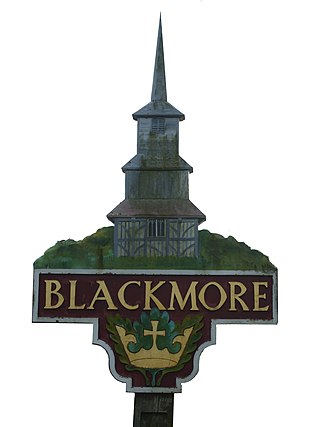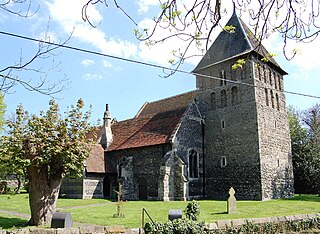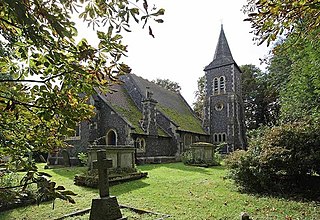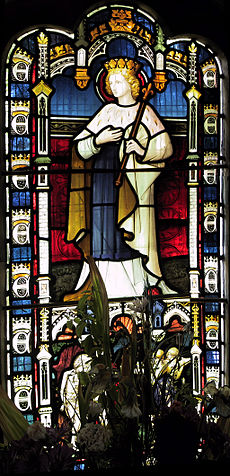
Acle is a market town on the River Bure on the Norfolk Broads in Norfolk, located halfway between Norwich and Great Yarmouth. It has the only bridge across the River Bure between Wroxham and Great Yarmouth.

Anglo-Saxon architecture was a period in the history of architecture in England from the mid-5th century until the Norman Conquest of 1066. Anglo-Saxon secular buildings in Britain were generally simple, constructed mainly using timber with thatch for roofing. No universally accepted example survives above ground. Generally preferring not to settle within the old Roman cities, the Anglo-Saxons built small towns near their centres of agriculture, at fords in rivers or sited to serve as ports. In each town, a main hall was in the centre, provided with a central hearth.

Chipping Ongar is a market town and former civil parish, now in the parish of Ongar, in the Epping Forest District of the county of Essex, England. It is located 6 miles (10 km) east of Epping, 7 miles (11 km) southeast of Harlow and 7 miles (11 km) northwest of Brentwood. In 2020 the built-up area had an estimated population of 6420. In 1961 the parish had a population of 1673.

Greensted is a village and former civil parish, now in the parish of Ongar, Essex, England, strung out along the Greensted Road approximately one mile to the west of Chipping Ongar. In 1961 the parish had a population of 711.

Blackmore is a village in Essex, England. It is located approximately 3 miles (5 km) east of Chipping Ongar and 4 miles (7 km) north of Brentwood. The village is in the parish of Blackmore, Hook End and Wyatts Green in the Brentwood district and the parliamentary constituency of Brentwood & Ongar. In 2018 it had an estimated population of 826.
A palisade church is a church building that is constructed with palisade walls, standing split logs of timber, rammed directly into the ground, set in gravel or resting on a sill. The palisade walls form an integral part of the load-bearing system.

St Michael's Church is a Church of England parish church in St Albans, Hertfordshire, England. Much of the building is late 10th or early 11th century, making it the most significant surviving Anglo-Saxon building in the county. It is located near the centre of the site of Roman Verulamium to the west of the modern city.

Corringham is a town and former civil parish in Essex, England, located directly next to the town of Stanford-le-Hope, about 24 miles (39 km) east of London and 3 miles (4.8 km) south of Basildon. Corringham lies on a hill overlooking the Thames between Canvey Island and Tilbury Fort. It is in the unitary authority of Thurrock, 6 miles (9.7 km) north-east of the administrative centre, Grays.

Woodeaton or Wood Eaton is a village and civil parish about 4 miles (6.4 km) northeast of Oxford, England. It also has a special needs school called Woodeaton Manor School.

East Mersea is a scattered village and civil parish on Mersea Island in the English county of Essex. It was historically referred to as Mersea in the Domesday book

St Peter's Church is the former parish church of Barton-upon-Humber in North Lincolnshire, England. It is one of the best known Anglo-Saxon buildings, in part due to its role in Thomas Rickman's identification of the style. It has been subject to major excavations. The former Church of England church is now run by English Heritage and houses an exhibition exploring its history.

Shelley is a partly rural village and partly residential conurbation in the Ongar civil parish of the Epping Forest district of Essex, England.

Anglo-Saxon turriform churches were an Anglo-Saxon style of church that were built in the form of towers. They can also be called tower-nave churches.

St Andrew's Church is a redundant Church of England parish church in the village of Wroxeter, Shropshire, England. It is recorded in the National Heritage List for England as a designated Grade I listed building, and is under the care of the Churches Conservation Trust. Both the village of Wroxeter and the church are in the southwest corner of the former Roman town of Viroconium.

St Mary's Church is a redundant Anglican church in the parish of Chickney, Essex, England. It is recorded in the National Heritage List for England as a designated Grade I listed building, and is under the care of the Churches Conservation Trust.

St Martin of Tours is a parish church in Detling, Kent. Dedicated to Martin of Tours, the building was constructed in the 12th century with 13th and 15th-century additions and restoration carried out in the late 19th century. It is a Grade I listed building.

St Giles' Church is in the hamlet of Barrow, Shropshire, England. It is an active Anglican parish church in the deanery of Telford Severn Gorge, the archdeaconry of Ludlow, and the diocese of Hereford. Its benefice is united with those of All Saints, Broseley, St Mary, Jackfield, St Bartholomew, Benthall, and St Leonard, Linley. The church is recorded in the National Heritage List for England as a designated Grade I listed building. It is one of the earliest surviving churches in Shropshire, and contains the county's only Anglo-Saxon chancel.

St Bartholomew's Church is in the village of Chipping, Lancashire, England. It is an active Anglican parish church in the deanery of Whalley, the archdeaconry of Blackburn, and the diocese of Blackburn. Its benefice is united with that of St Michael, Whitewell. The church is recorded in the National Heritage List for England as a designated Grade II* listed building.

The Church of St Margaret is a 14th-century grade II* listed church near Bowers Gifford, Essex.

St Mary's is a Grade II* listed parish church in the village of Buttsbury, approximately 1.5 miles north west of Ingatestone and 3.8 miles south east of Billericay in Essex, England. The present building dates from the 14th century, but St Mary's Church was mentioned in 1170century, the site is believed to have been where St Botolph preached under a pear tree in the 7th century.






















